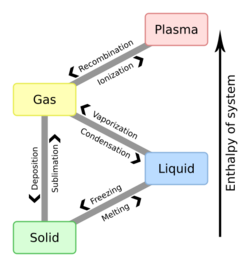Physics:Enthalpy of sublimation
From HandWiki
Short description: Heat required to change one mole of substance from solid to gas
In thermodynamics, the enthalpy of sublimation, or heat of sublimation, is the heat required to sublimate (change from solid to gas) one mole of a substance at a given combination of temperature and pressure, usually standard temperature and pressure (STP). It is equal to the cohesive energy of the solid. For elemental metals, it is also equal to the standard enthalpy of formation of the gaseous metal atoms.[1] The heat of sublimation is usually expressed in kJ/mol, although the less customary kJ/kg is also encountered.
Sublimation enthalpies
| symbol | substances | Sublimation enthalpy (kJ/mol) |
|---|---|---|
| Li | lithium | 159[1] |
| Na | sodium | 107[1] |
| K | potassium | 89[1] |
| Rb | rubidium | 81[1] |
| Cs | caesium | 76[1] |
| Mg | magnesium | 148[1] |
| Ca | calcium | 178[1] |
| Sr | strontium | 164[1] |
| Ba | barium | 180[1] |
| Fe | iron | 416[1] |
| Ni | nickel | 430[1] |
| Cu | copper | 338[1] |
| Zn | zinc | 131[1] |
| Ag | silver | 285[1] |
| W | tungsten | 849[1] |
| Au | gold | 366[1] |
| C | graphite | 717[1] |
| C | diamond | 715[1] |
| Si | silicon | 456[1] |
| Sn | tin | 302[1] |
| Pb | lead | 195[1] |
| I2 | iodine | 62.4[2] |
| C10H8 | naphthalene | 72.9[2] |
| CO2 | carbon dioxide | 25[2] |
See also
- Heat
- Sublimation (chemistry)
- Phase transition
- Clausius-Clapeyron equation
References
- ↑ 1.00 1.01 1.02 1.03 1.04 1.05 1.06 1.07 1.08 1.09 1.10 1.11 1.12 1.13 1.14 1.15 1.16 1.17 1.18 1.19 1.20 1.21 Oxtoby, D. W; Gillis, H.P., Butler, L. J. (2015).Principles of Modern Chemistry, Brooks Cole. Appendix D. ISBN 978-1305079113
- ↑ 2.0 2.1 2.2 Chickos, James S.; Acree, William E. (2002). "Enthalpies of Sublimation of Organic and Organometallic Compounds. 1910–2001" (in en). Journal of Physical and Chemical Reference Data 31 (2): 537–698. doi:10.1063/1.1475333. ISSN 0047-2689. http://aip.scitation.org/doi/10.1063/1.1475333.
 |


